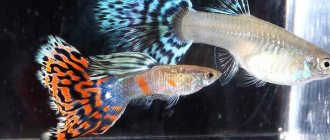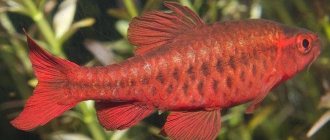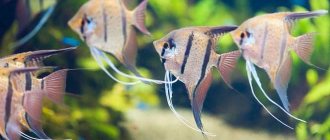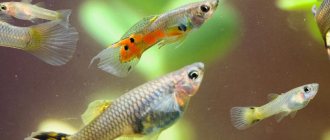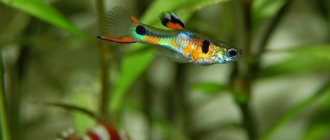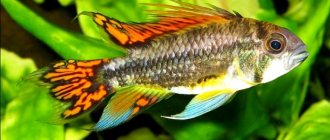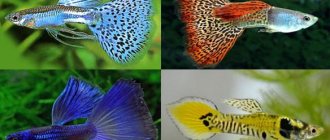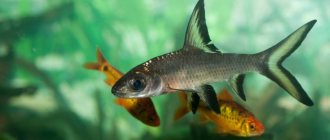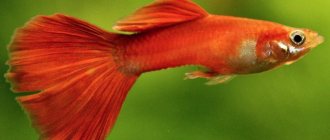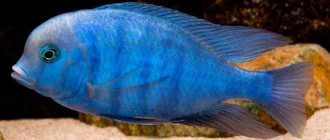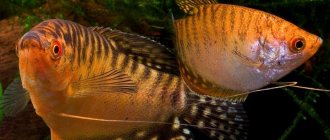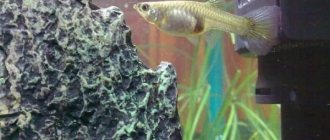Barbus
Barbs are ray-finned spawn-marking fish from the carp family, representatives of the genus Barbus.
They have become popular in the aquarium hobby because of their unpretentiousness and variety of colors (now there are even fluorescent ones). They are nimble and fast, but carry the stigma of being “badass”. Some even consider them predatory, but this is far from the case. Proper compatibility of barbs with other fish is quite possible. It's all about the right neighbors and a suitable aquarium.
Fluorescent barbs are a genetically modified species. They cannot reproduce.
Barbs live 5-7 years, but during this long life for a fish, many of them can only grow up to 5 cm. Although the size of some species can range from 6 to 35 cm.
Fish in their natural environment live in rivers and streams with slow currents and warm water (25 degrees), sandy soil and dense vegetation, which must be created in the aquarium. Barbs like to burrow into the ground so that they do not harm themselves; there should be sand there, not large pebbles or crushed stone.
Character of barbs
A common description of barbs is “badass fish.” They can often be seen arguing with each other or with their tankmates. In general, representatives of this genus are peaceful, but if the species are not selected correctly, they can turn into aggressors. Sumatran barbs have a particularly pugnacious disposition. Slow-moving fish and species with veil fins are most often attacked by them. Barbs are extremely mobile, they swim quickly and love to explore all corners of an artificial pond. Neighbors are selected for them in accordance with these characteristics of character and behavior.
Sumatran barb.
Incompatible species
Cockerels
This group of fish gets along poorly with absolutely everyone. They attack and bully others; barbs will gnaw the tail and fins of the cockerels in retaliation. Constant skirmishes can even lead to the death of weaker fighters.
Angelfish
The chic fins of calm angelfish barbs will be happy to pat. Small striped predators will especially bully young individuals that have not yet reached a large size and are not at all able to fight back.
Guppy
Small fish can be eaten by barbs. Barbs will attack and injure even large adult individuals, cutting off the beautiful tails of male guppies. As a result, harmless guppies die. Worst possible neighborhood.
Lyalius
Unlike their closest relatives - gourami - lalius are more timid and characterized by their lack of conflict. This will be a reason for the Sumatrans to attack, bite and tear off the thin thread-like fins of the Labyrinths.
Astronotuses
In this case, the barbs will suffer, which the astronotus will eat without even noticing. This large, voracious and aggressive fish reaches 30-35 centimeters in length. Despite its apparent slowness, it is a deadly predator, for which even a whole flock of “minke whales” is not enough for a full meal.
Cichlids
These are the most aggressive fish that get along well only with catfish. Cichlids fiercely defend their territory. They will not huddle and want to own the entire aquarium, so they will corner the barbs. In addition, with such a neighborhood, sooner or later the “minke whales” will be eaten.
Neons
Small and harmless neons will be a complete and balanced breakfast for barbs. If you do not want to lose half of your pets, it is better not to house these species together.
Factors Affecting Compatibility
The compatibility of barbs with other fish species is influenced by the following factors:
- Aquarium size. Since representatives of this genus require a lot of free space for swimming, a spacious tank should be prepared for them. It is desirable that it have a rectangular, elongated shape. This way you can reduce the likelihood of fights over territory.
- Availability of shelters. In order for other fish to be able to hide from their overly active counterparts, it is necessary to place a sufficient number of shelters in the reservoir. The best option would be dense thickets of plants, which are planted in sections, leaving space for swimming between them.
- Presence of relatives. Representatives of the genus are schooling fish; They are recommended to be kept in groups of 6-8 individuals. In this case, they will work to sort things out among themselves and will not bully other inhabitants of the aquarium. When kept alone or in pairs, these fish begin to show aggression towards their neighbors.
- Selection of neighbors. For keeping together, fish of similar size and temperament should be selected. Species that are too slow, have long and lush fins, shy or small species do not get along with their active neighbors.
- Proper feeding. In order not to provoke fights for food, the fish must be fed properly. The diet should be complete, when using live, frozen and dry food - varied, satisfying all the needs of the body. Feed must be supplied in sufficient quantities so that aquatic animals do not starve.
Maintenance and care
The variety of barb species can truly surprise you. Among them there are species whose individuals grow on average up to 4-6 cm in length, and there are also those that reach a length of 30-35 cm. You should choose an aquarium based on its dimensions based on the size of adult barbs. After all, our goal is to create comfortable conditions for their living. The lifespan of barbs is that with proper care they live up to 6-7 years.
If you do not plan to keep “giants,” then an aquarium of 50 liters or more is standard for a flock of most species of barbs. Its shape is preferably elongated (i.e., a rectangular aquarium). Be sure to ensure there is a lid. These fish are very active and jumping with acceleration is not uncommon during their play. The barb can also accidentally jump out if something or someone frightens it.
Equipment
Fish love warm, well-oxygenated water. Therefore, when preparing the aquarium, the following equipment is installed:
- A compressor that will aerate the water in the aquarium. Oxygen is actually of great importance for all fish, and it is also important for plants;
- Filter for water purification. It can be internal or external. The key point when choosing is its power. If possible, you can choose a filter with additional functions, namely flow control. These fish love it when there is a strong current;
- A thermostat whose task is to maintain the optimal water temperature for barbs.
When decorating an aquarium, the best option is a natural style. Perhaps you will be inspired to come up with various ideas from the information that the habitat of these aquarium inhabitants in their natural environment is South, South-West (Borneo, Sumatra, Thailand, Cambodia) and Southeast Asia, as well as Africa. Some of them live in India and on the island of Sri Lanka. Barbs are found in equatorial Africa.
Place living plants, stones and driftwood of unusual shape and appearance in the water. Various available materials can be used to build grottoes and caves that can serve as shelter for fish.
Water
These fish are very unpretentious. They quickly and easily adapt to almost any water. Neutral or slightly acidic water is considered optimal.
Optimal water parameters:
- Quite warm with a temperature of 20-25°C.
- Acidity levels are within 6.5-7.5.
- Water hardness indicators are from 4 to 10 dGH.
Caring for fish involves a mandatory water change - about 30% of the volume. They should be done once a week. This will avoid the accumulation of harmful and dangerous fish waste products in the aquarium.
Priming
It is best to use a specialized primer with a neutral reaction. This will guarantee the safety and quality of its composition, as well as the composition of the water. In this case, sea pebbles, quartz sand (coarse) and baked clay soil are suitable. The optimal soil fraction is 2-4 mm. Please note that barbs look more contrasting and impressive against the background of dark soil.
Lighting
Another advantage of barbs, for which aquarists love them, is that they feel great in any lighting. Therefore, when organizing it, you can safely focus on the types of living plants that will grow in the aquarium and the overall design.
Plant selection
Actually, you can choose the plants to your taste. Among the most popular species, Anubias, Echinodorus, Vallisneria, Cabomba, etc. are often chosen. In this case, the planning of their landing is more important. It is recommended to zoning the space into several areas. The aquarium should have open areas where the barbs will frolic, as well as areas with densely planted plants. Such thickets will serve as a natural shelter and resting place for fish.
Compatibility table
To find out with whom barbs get along and with which species they should not be housed, you can use the following table. However, when selecting housing for a general aquarium, you should be guided not only by the nature and characteristics of specific species. It is equally important to consider the size of the artificial pond, its design, the expected feeding schedule and other factors.
Compatible
Aquarium barb fish are compatible with the following aquatic organisms:
- Other types of barbs. In one aquarium you can keep 2-3 flocks of representatives of different species of the genus. Most of them are characterized by similar sizes, character and behavioral characteristics, as well as requirements for living conditions.
- Swordtails, mollies, platies. These viviparous fish are characterized by mobility, a peaceful disposition and a size similar to barbs. For comfortable keeping together, you should select varieties that do not have veil fins. Neighbors can eat the fry, so for breeding the fish are placed in a separate container.
- Melanothenia (iris). Due to their similar size, mobility and peaceful nature, schools of these fish are able to live with barbs.
- Danios and rasboras. These small, calm fish stay in schools in the upper layers of the water, while barbs live mainly in the middle layer. Thanks to this feature, they do not conflict over territory. These fish are especially well suited for companionship with small species of barbs, for example, cherry barbs.
- Ancistrus and Corydoras. These catfish lead a bottom lifestyle, so they practically do not attract the attention of species living in the middle layers of water.
- Neons. These small schooling fish, with a calm disposition, usually do not become victims of aggressors.
- Labeo. These lively fish, known for their territorial behavior, are able to fend for themselves in the event of aggression from representatives of other species.
- Tetras. These fish are similar to barbs in size and temperament, so they do not become their victims.
- Botsiya. These fish are quite large in size, have a fighting nature and territorial behavior, thanks to which they are able to get along with barbs.
Limited compatible
The following fish get along in the same aquarium with barbs only if conditions suitable for this are created. It is necessary to carefully monitor the behavior of the fish, as clashes between them are possible. The following hydrobionts are limitedly compatible with barbs:
- Cichlids. These are fish with pronounced territorial behavior. Species of medium and small size are able to get along with barbs, but can show aggression towards them during the spawning period.
- Guppy. Most breeds of guppies have veiled fins, which can be torn off by their lively neighbors. However, when kept in a school and in a sufficiently large volume, these fish are rarely attacked.
- Shrimps. These are gentle and slow inhabitants of the aquarium, which can become victims of attacks by predatory neighbors. To protect shrimp from aggressors, it is necessary to place a sufficient number of small-leaved plants or mosses in the tank, among which arthropods can hide.
Not compatible
It is not recommended to keep barbs in the same volume with the following species:
- Gourami, lalius and other labyrinths. All labyrinth fish have long, whisker-like pelvic fins that they use for touch. In addition, these fish are slow, and some of them (for example, lalius) are shy. All this makes them an easy target for barbs. If kept together with these aggressors, labyrinth fish will lose their whiskers and will experience constant stress.
- Cockerels. Despite their aggressive nature, bettas also suffer from attacks due to their slowness and lush fins.
- Angelfish. These peaceful cichlids are slow-moving and have long fins that attract active neighbors.
- Astronotus and other large cichlids. These are predators who will perceive smaller fellows as prey.
- Goldfish. In addition to diverging requirements for environmental parameters (in particular, temperatures), these fish are characterized by slowness, clumsiness, and the presence of vulnerable body parts (depending on the breed, these could be eyes, growths on the head or fins) that will be subject to attack.
Fire barb.
Description
The body is elongated, the caudal fin is two-lobed. The color of the scales depends on the specific species and is very diverse: you can find solid colors, with spots, transverse and longitudinal stripes. Sexual dimorphism is weakly expressed in most species. Females are usually larger, with a large rounded abdomen, but less intense coloring than males.
Barbs are characterized by a gregarious lifestyle. They simply need a group of relatives. Usually these are flocks of 6-10 individuals. But when alone, they experience severe psychological stress and may even begin to attack other inhabitants.
It is impossible not to mention the attractiveness of barbs. There are a huge number of their varieties. A flock of bright, beautiful fish, always on the move, will become a real decoration for both the general and species aquarium.
There are also no difficulties with breeding barbs. These are spawning fish and are often chosen by beginners to begin mastering the art of breeding aquarium fish.
External characteristics
There are many varieties of aquarium barbs. They are distinguished by a variety of colors. Thanks to selection work, it was possible to obtain individuals with bright and very beautiful scales. The body of barbs is slightly flattened laterally, the fins are relatively small, and the tail is slightly forked. The head has antennae above the upper jaw. The females are slightly larger than the males.
When it comes to color, there are many different options. For example, mutant barbs have an emerald color. Ruby barbs are red in color, and during mating season it becomes very bright. Oligolepis have scales with a pearlescent tint, and a dark edging is noticeable along the edges of their fins. The Everett barb is colored in a particularly original way: they have blue and black spots over the entire surface of the body. There are also striped varieties - they have multi-colored stripes along the entire length of their body. However, there are also barbs with transverse stripes (Sumatran or tiger barbs).
Who do you get along with best?
As a conclusion, we can briefly list the best neighbors for Sumatrans and their immediate relatives.
Most suitable neighbors:
- catfish;
- zebrafish;
- battles;
- other barbs of the same size.
With caution, you can add apistograms, gourami and large swordtails.
Reproduction
Reproduction of striped puntius at home is not difficult; on the contrary, the spawning of Sumatran barbs will arouse interest among both experienced and novice aquarists. Let us consider in detail the process of reproduction of barbs.
Sumatran barbs reproduce at the age of 6-9 months; before spawning, the fish are intensively fed with live food for 2 weeks. To choose a future pair of parents, you should know how to distinguish a female from a male:
- Sexual dimorphism in fish is weak, but males are smaller than girls.
- During spawning, the nose of males becomes scarlet, and the abdomen of females becomes rounded.
Having chosen a pair, the fish are placed in a spawning tank with a capacity of at least 10 liters. You don't need soil for the container; instead, you can use mesh or Java moss to preserve the eggs. Spawning is stimulated by raising the temperature to 25-26C, and soon the female lays eggs.
After spawning, the parents are returned to the old aquarium, the water is partially renewed, and the tank is darkened. Some of the eggs will be light-colored - unfertilized, so they are removed from the spawning tank. After a couple of days, larvae are born, and after another three, fry. Babies are fed ciliates and live dust every 3-4 hours. In order for the offspring to grow up healthy and developed, you should keep the lighting on, and as the babies grow, diversify their diet.
Diseases
Despite the easy maintenance of barbs, the fish often die due to improper conditions. Given that punts are prone to gluttony, the phenotypes suffer from obesity, which is the most common cause of death in pets.
In addition to this disease, barbs are susceptible to rubella, a dangerous disease. Pets can become infected from a neighbor, untreated soil or plants. The symptoms of the disease are pronounced: the eyes of the fish bulge, ulcers form on the body, and the abdomen swells. As the disease develops, the fish refuse to eat, and then the disease leads to death. To save barbs, aquarists use methylene blue, making baths and dipping sick pets into them.
In addition to diseases, the reason for the deterioration of the condition of fish is the crossing of close relatives. In this case, barbs may be born with anomalies and pathologies.
Sumatran barbs are playful and active fish that will not let aquarium residents get bored. Considering the interesting behavior of striped puntius, as well as easy care and maintenance, for many aquarists the Sumatran barb is a sought-after and desirable resident.
Adviсe
- Do not overfeed barbs.
- Plant a sufficient number of plants.
- Choose a shallow aquarium rather than a long one.
- Do not share with slow and stately fish.
- Do not share with small fish or fry.
The Sumatran barb will enliven any aquarium with its cheerful temperament and will be an excellent decoration. If it seems to you that the aquarium has become slow and lifeless, then buy a barb. These fish will quickly create vigorous activity in the water; all you have to do is watch them.
(Visited 729 times, 1 visits today)
Feeding
Striped punts are gluttons who happily eat absolutely everything: dry and live food, plant foods. However, if you plan to spawn Sumatran barbs, then you should feed the fish carefully, including frozen and live food in the diet as a basis. The best option would be tubifex, coretra, bloodworms and daphnia.
Pets are systematically fed with greens or dandelion, after scalding the plants with boiling water. Barbs are fed once a day, maximum 2 times. If you do not follow this rule, the fish will soon develop diseases or obesity, and the pets will die.
Conclusion
Barbs are perfect for keeping in an aquarium for those who love sharp, nimble, active fish. They are not so whimsical in their maintenance; they like to live in a flock. They are not aggressive, but can sometimes be aggressive within a species or on other fish (just make sure that the fish are truly compatible with each other, although they can get along with many species). Small species live up to 5 years, which can delight you for a long time in your aquarium!
Previous
Arowana fish - appearance preserved from the Jurassic period
Next
Fish: Synodontis catfish, which swim belly up 80% of the time
